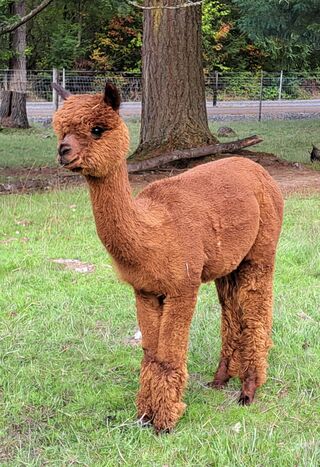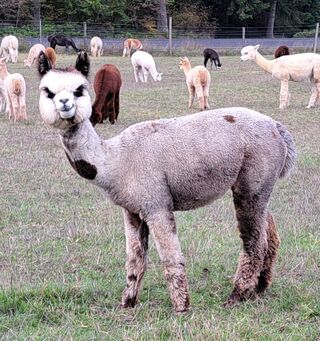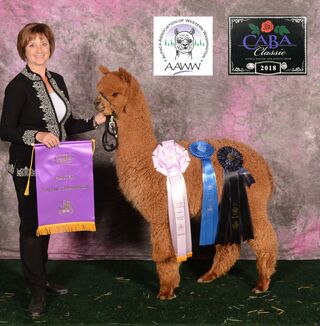ABSUSA
Alpaca Breed Standard for the United States of America (ABSUSA)
Preamble:
This standard has been developed for the benefit and perpetuation of the alpaca breed.
The Mission:
The ultimate goal of this standard is to achieve overall improvement of the alpaca by providing a general description of a physically sound and phenotypically correct alpaca.
As an integral part of a responsible breeding program, overall soundness will be evaluated and considered a top priority. Breeders who utilize this standard will achieve more efficient quality improvement and higher productivity in their herds.
Purpose:
The purpose of this standard is to act as a guide for breeders to improve desirable traits pertaining to overall health, vigor, soundness, reproduction, longevity, temperament and fiber quality. Acceptable parameters for some straits are provided. For example, fiber coverage and density and heavy or light builds are variable traits that can be selected to allow for better adaptability to the environments in which the alpacas are expected to thrive.
How to use this standard:
Evaluate the traits of each individual alpaca based on its lineage (ancestry), appearance, fiber attributes and a thorough veterinary evaluation. After evaluation and identification of traits needed for improvement, pair complimentary alpacas for mating with the goal of producing an offspring that is superior to both its sire and dam.
[In order to remain concise, the scope of this standard has been limited. Therefore, The Medicine and Surgery of South American Camelids (Fowler), The Complete Alpaca Book (Hoffman), The Secrets of the Andean Alpaca (Krieger), The AOBA Show Division Handbook and The Comprehensive Alpaca Record and Evaluation (CARE), are recommended companions to this document.]
Alpaca Phenotype:
The archetypical alpaca is a robust and alert animal with a strong herd instinct.
A well-developed alpaca head looks strong and handsome. The muzzle is of medium length and wedge shaped when viewed from the side, not dished or humped. The nostrils are large and well-defined and do not flare when at rest or after mild exertion. The upper lip is split for food gathering. The lower incisors should be covered by the upper dental pad to allow for natural wearing. The molars (cheek teeth) should fit together to allow for proper mastication and ruminating. The eyes are large, wide-set, slightly oval shaped and protrude slightly from their sockets. Eye color may be brown, gray, mixed (blue-eyed alpacas are not desirable for the health of the eye and they can also be deaf). The ears are symmetrical and spear-shaped of medium length and are covered with short hairs. The top knot, a trait unique to the alpaca amongst the camelids, should be full and resemble the blanket fiber's characteristics. The muzzle and cheeks may be clean or fleece covered (varies according to genetics, age and seasons). The fiber should not interfere with vision.
Balanced proportions are essential for proper body movement. The neck should be two-thirds the length of the back with the legs matching the length of the neck. Neck set is slightly forward due to a subtle curve at the base of the neck. The top line is predominantly straight and level (may vary according to age). The rump should be wide and slightly rounded with a low tail set. The chest should be deep with well-sprung ribs to allow for adequate breathing under exertion. The abdomen is narrow, not overly large which would impede running ability. The legs should exhibit an upright stance with even spacing and with all four feet pointing forward. The four gaits, walk, pace, trot, gallop, are smooth and flowing. There are two toes on each foot (not splayed or fused), and no more or less than four well-developed nipples on the udder.
Huacaya and Suri Fleece Characteristics:
The huacaya alpaca is characterized by a lustrous fleece with bold crimp that causes the fleece to grow perpendicular from the body. This creates a fluffy appearance. The crimp ranges from low to high in regards to amplitude and frequency.
The suri alpaca is characterized by a highly lustrous fleece that lacks crimp. The fiber forms ringlets and hangs close to the body.
A third "chili" type fleece is recognized which has fleece that lacks overall uniformity if characteristics.
Uniformity of fineness, character, length, luster and color throughout the fleece is necessary for the highest yield of prime fiber and thus ease of manufacture and highest quality end products.
Fiber coverage of both the suri and huacaya may range from nearly complete coverage to coverage from the jaw to just above the pasterns. Fleece weights range approximately from 3 to 12 pounds annually. Yield is determined by the follicle density, fiber diameter and staple length.
January 19, 2012


